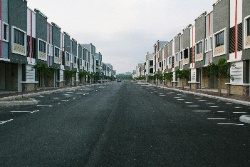Water Pollution Problems Likely From Gold Mine
Major Water Pollution Problems Likely From Gold Mine
Inadequate information about mine design mean that water pollution problems from a proposed Reefton gold mine cannot be properly assessed, according to reports obtained under the Official Information Act by the Royal Forest and Bird Protection Society.
“The mine proposed by GRD Macraes Ltd on conservation land would create New Zealand’s largest toxic waste dump,” Forest and Bird field officer, Eugenie Sage said.
“The proposal includes 75 ha of tailings dumps, where the tailings slurry is contaminated by heavy metals, and additional sources of acid mine drainage in the 105 ha of waste rock stacks and the 46 ha open pit.”
“The papers were recently released by the Department of Conservation after a four month delay. Conservation Minister, Sandra Lee is considering an application for access to 550 ha of conservation land in Victoria Conservation Park close to Reefton by GRD Macraes for its proposed Globe Progress mine.”
“Water discharges (both during the operation of the proposed mine and after it closes) will create an ongoing and heavy pollution load in local streams and the Inangahua River and may contaminate groundwater. Discharges include elevated levels of heavy metals such as arsenic, copper, cadmium, lead, and zinc.”
“A report by independent consultants for the Department of Conservation highlights the major information gaps and uncertainties about the extent of water pollution, particularly from the tailings dumps and waste rock stacks.”
“It would be irresponsible for the Minister to consent to mining given the poor information and the serious and permanent water pollution problems which hard rock gold mines cause,” Ms Sage said.
“A report by URS Woodward Clyde Dames and Moore indicates that :
- “the level of detail and design is not comparable to that presented as part of the permitting process for other mine sites throughout New Zealand.”
- the level of risk from the tailings impoundments or their proposed management cannot be assessed because of inadequate information.
- seepage from the waste rock stacks may have to be treated for “an extended period” after mining finishes. Lack of information about the expected geochemistry of the tailings water and seepage meant these discharges could not be evaluated.
- the adequacy of silt ponds and stormwater control measures could not be assessed because of inadequate information.
- the company is likely to have under-stated the capacity of the waste rock stacks to generate runoff contaminated by arsenic because it has changed the definition of
what constitutes “low arsenic” rock.”
“Hard rock mining causes much more pollution and is very different from traditional West Coast alluvial gold mining,” Ms Sage said.
“Allowing the mine to proceed would be digging up trouble on a huge scale. It would expose the Crown and West Coast ratepayers to substantial financial and environmental risks for generations to come, particularly in managing the water pollution from the mine.”
“The proposed $8 to $20 million bond and insurance is very unlikely to be adequate to cover ongoing management costs or remedy reasonably foreseeable adverse effects,” Ms Sage said.
“Attempts to stabilise the tailings impoundment at Coromandel’s troubled Waitekauri mine at a site which was supposed to be geologically stable have already cost well over $27 million. Tailings dams have a very poor safety record.”
“Acid mine drainage from waste rock stacks, the exposed walls of mine pits and the tailings dams is a recurrent problem with hard rock mines. Reefton’s high rainfall would exacerbate this water pollution problem.”
Ends
Note to media
1. Information comes from “Review of Mine Proposal for Access Variation Agreement” by Clive Anderson of URS Woodward Clyde (16 February 2001) at para 4.1.
2 Other gold mining on the West Coast is alluvial mining which involves excavating gold bearing gravels and washing this over screens or mats to extract the gold. Hard rock mining involves crushing rock (ore), then mixing it with water and chemicals to form a slurry. This is processed to produce a sulphide concentrate from which gold is extracted using a pressure oxidation system and a cyanidation process. The tailings slurry is a toxic cocktail of heavy metals such as copper, antimony, arsenic and cadmium. The two tailings dumps at the proposed GRD Macraes mine would contain more than 13 million tonnes of tailings.
Hard rock mining creates large volumes of waste rock (an estimated 109 million tonnes of waste rock and 11 millon tonnes of ore at Globe Progress). When this is exposed to rain and weather, the sulphide bearing minerals in the rock oxidise releasing sulphuric acid which in turn dissolves metals (e.g. copper, zinc, cadmium) in the surrounding rock. Often this process is accelerated by a type of bacteria (Thiobacillus fero-oxidans) which thrives in an acidic environment. This acidic run off contaminated with heavy metals can persist at mine sites for centuries. Some acid mine drainage is 10 times as strong as battery acid.
Controlling acid mine drainage involves keeping air, water and bacteria away from the sulphide minerals. Because these minerals can be present in the tailings, waste rock
and exposed pit walls controlling acid mine drainage, particularly in the piles of
waste rock is almost impossible. Over time the sealing layers on the waste rock
stacks will become ineffective and Department of Conservation reports say leachate penetration is inevitable.
GRD Macraes Ltd expects the Globe Progress mine to last 10-15 years. The company is responsible for the site for only 10 years after mining ends or the resource consents expire. After that (or before if the company suffers financial problems), the Department of Conservation as landholder, and the Buller District Council and West Coast Regional Council would be responsible for rehabilitation and maintenance of the pit, collection and treatment of contaminated water, the waste rock stack security, stability of the tailings impoundments and other mine workings.


 Gordon Campbell: On unemployment, Winston Peters’ low boiling point and music criticism
Gordon Campbell: On unemployment, Winston Peters’ low boiling point and music criticism ACT New Zealand: Investment In Prisons Delivers On ACT Commitment
ACT New Zealand: Investment In Prisons Delivers On ACT Commitment Labour Party: National Gaslights Women Fighting For Equal Pay
Labour Party: National Gaslights Women Fighting For Equal Pay The Treasury: New Treasury Paper On The Productivity Slowdown
The Treasury: New Treasury Paper On The Productivity Slowdown NZ Government: Government Recommits To Equal Pay
NZ Government: Government Recommits To Equal Pay Emily Ireland - Local Democracy Reporter: Deputy Mayor ‘disgusted’ By Response To Georgina Beyer Sculpture
Emily Ireland - Local Democracy Reporter: Deputy Mayor ‘disgusted’ By Response To Georgina Beyer Sculpture Te Pāti Māori: Māori Unemployment Rate Increases By More Than Four-Times National Rates
Te Pāti Māori: Māori Unemployment Rate Increases By More Than Four-Times National Rates


